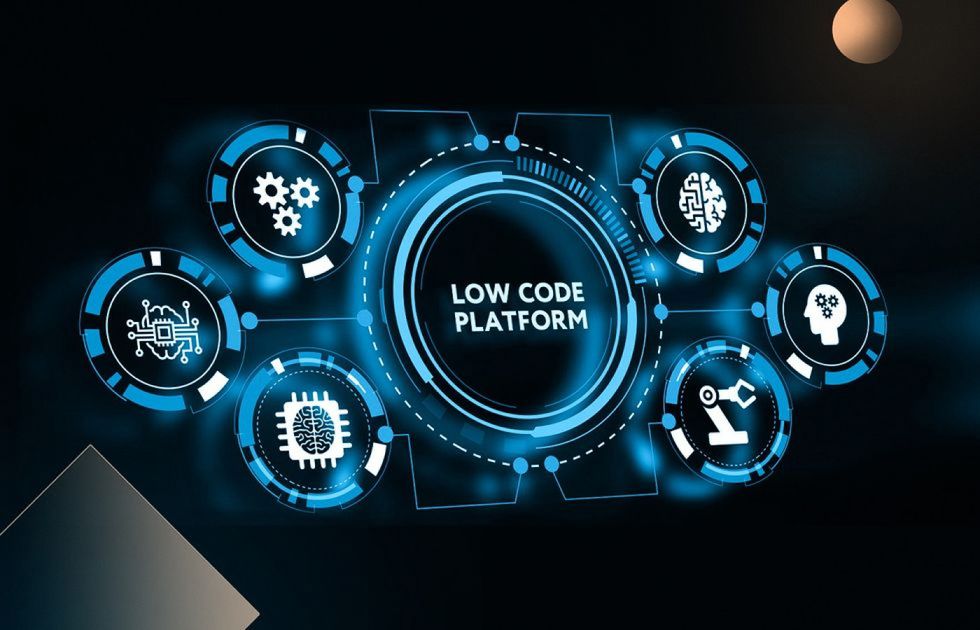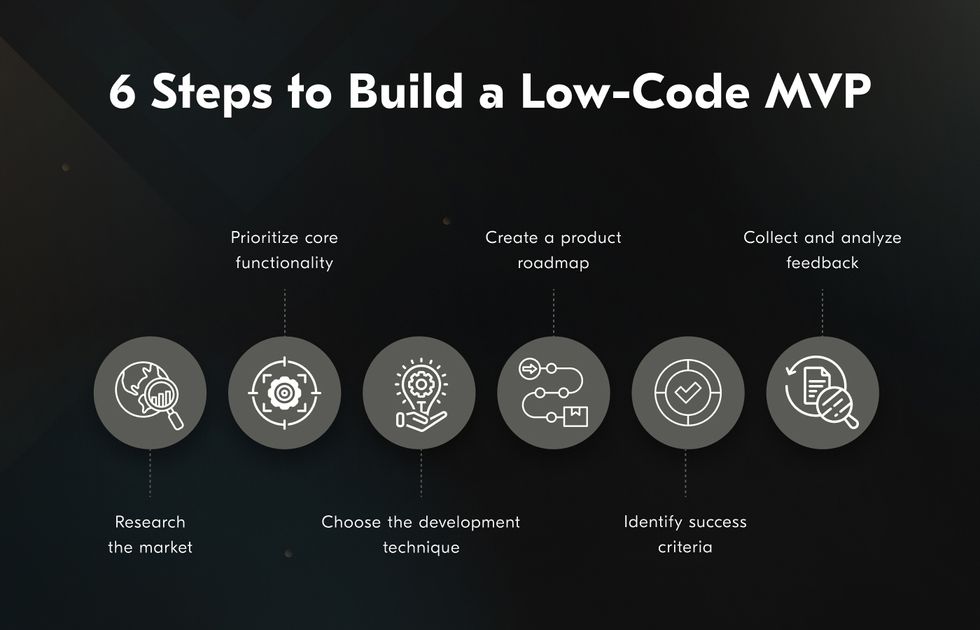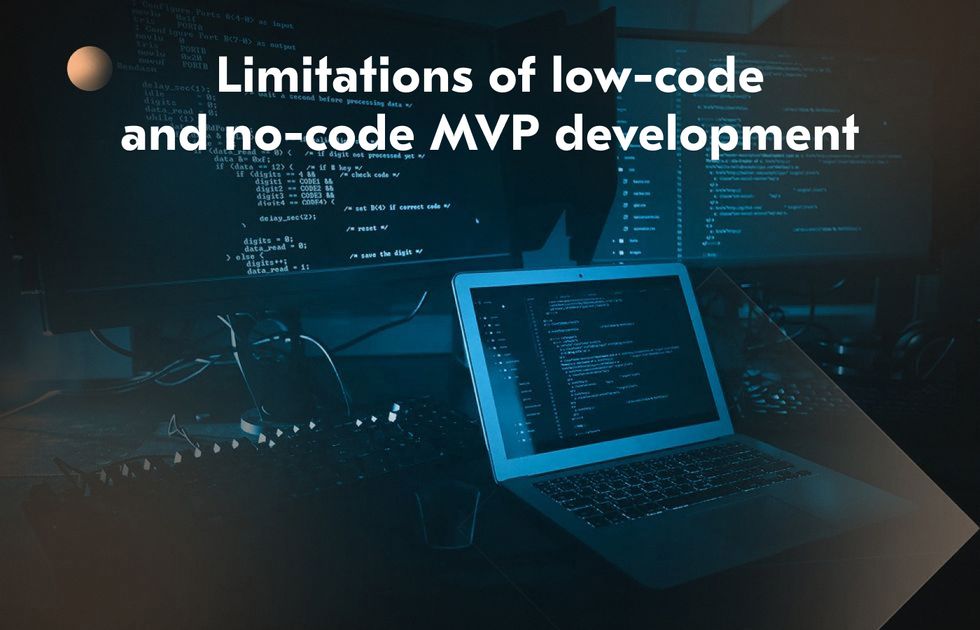
Key Takeaways
- No-code and low-code MVP development allows you to validate ideas without needing expensive development teams or advanced technical infrastructure.
- By 2025, approximately half of IT leaders are expected to implement low-code or no-code technologies.
- The global low/no-code platform market, valued at $12.62 billion in 2023, is projected to reach $51.25 billion by 2028.
- Forrester reports that 87% of companies use low-code to innovate, with 60% of managers surveyed by KPMG calling it “critical to very critical” for future performance.
You can’t know if your application will succeed until you actually launch it. Does that mean you should invest in full-scale development? Not exactly. Low code or no-code MVP (minimum viable product) development approaches let you validate concepts without investing in skilled (and expensive) development teams and an advanced technical stack. With an MVP, you can test your product ideas more cost-effectively and faster than if you’d built a full-scale software product. Low-code and no-code tools facilitate the process with visual programming and reusable components, with 89% of CIOs and IT experts reporting that low-code development effectively increases efficiency.
However, this approach requires thorough planning and an understanding of its limitations. With over two decades of developing tailored software for businesses of any size, Acropolium has gained numerous strategic insights on cost-efficient low-code development.
Today, we will share how to build a low-code MVP as cost-effectively as possible and avoid the most common mistakes companies make during development.
What is Low-code MVP Development?

Low-code MVP development involves using low-code platforms to build a minimum viable product fast and effectively. These platforms provide visual interfaces and pre-built components that simplify the development process, allowing businesses to build and launch their MVPs with minimal coding.
This approach enables faster time-to-market, reduced development costs, and greater flexibility. Therefore, building low-code MVPs is valuable for companies looking to validate their ideas and gather user feedback with a functional product.
Around 50% of IT leaders anticipate adopting low-code or no-code technology by 2025. Given the potential for economic slowdown and budget constraints, accelerating the adoption of low-code solutions is a practical approach. Valued at $12.62B in 2023, the global low/no-code platform market is expected to hit $51.25B by 2028.
Advantages of Low-code MVP Development

Now, let’s see how using low-code platforms and tools can augment your low-code MVP development process.
No need for extensive engineering skills
According to Gartner’s research, over half of low-code users will be non-technical by 2025. Low-code tools replace hand-coding with drag-and-drop features, allowing entrepreneurs and industry professionals without engineering skills to participate in the development.
Higher efficiency
Additionally, such platforms offer ready-made tools, reusable code, pre-built connectors for integrations, and templates for various development scenarios. Some solutions come with in-depth analytics, monitoring, and A/B testing features to optimize system performance.
Smoother integrations
Low-code MVP app development ensures integrations with third-party services. And did we mention that low-code platforms are compliant with various industry standards off-the-shelf?
Sophisticated low-code platforms can even be used to build custom apps with complex business logic. In 2024, it’s expected that 75% of large enterprises will utilize at least four low-code development tools for both IT and citizen development projects.
Reduced cost
Low-code helps 87% of enterprises reduce development costs. It allows companies to spend less money hiring professional development teams, while saving on hardware infrastructure, development software, and licenses. In other words, these tools let you build your low-code MVP with less effort and, consequently, fewer investment.
Improved scalability
Your MVP can have significantly more users than planned, meaning you might require more resources. Most no-code and low-code tools are available on scalable cloud-based architectures. This means you can build a low-code MVP with limited functionality and enhance it with new features in subsequent iterations.
Forrester reports that 87% of companies use low-code to innovate their software. At the same time, 60% of surveyed managers consider low-code development “critical to very critical” for their company’s future performance.
Reduced technical debt
Low-code can help you optimize backend processes and outdated systems. Some platforms automatically incorporate clean code and the latest security standards, eliminating the need to modify apps for different operating systems manually.
They also handle software updates, regulatory certifications, and performance maintenance. As a result, you can reduce your overhead resources for your IT teams.
Faster deployment
65% of companies turn to low-code solutions for faster time-to-market. Reusable modules and code templates can become building blocks for your MVP. At the same time, you can quickly add third-party services to your solutions.
Better product focus
The faster you deliver your MVP, the more users and feedback you get early on. It gives you more time to analyze what works, solve the issues that hold you back, and attract potential investors faster than competitors.
Low-code and No-code MVP Approaches

Low-code should help you deliver an MVP to the market with as little resources as possible. At the same time, your product should have enough features to gather customer feedback and attract investors.
Now, let’s look at the low-code use cases and approaches companies use for their MVPs. Depending on the product’s scope, you can adopt one of the following approaches:
Multi-capability MVP. This approach involves creating a product with core functionality and secondary features. You might need to combine multiple low-code tools with manual programming, which requires more effort and resources.
Single-feature MVP. It means sticking to one key feature that addresses the audience’s primary problem. You might also add other features your solution needs to work. For instance, an MVP for an NFC payment app still has to allow users to register their bank cards. Some no-code and low-code platforms are enough to build single-feature MVPs without hand-coding.
Concierge MVP (manual-first MVP). It allows you to mimic backend processes manually for your MVP. Say, you’re building a recommendation platform powered by machine learning. This approach lets you design an app using low-code software but also allows your employees to produce recommendations. So, you can gather customer feedback about a product without spending a fortune on a sophisticated AI system and feeding it heaps of data.
Product demo. Companies often showcase their product without building a single line of code. A simple no-code platform is enough to create a landing page or video that presents a problem, proposes a solution, and highlights advantages over competitors.
Crowdfunding. Low-code platforms are excellent for building straightforward MVPs and promotion materials for crowdfunding campaigns. This lets you validate your business idea, engage with the audience, and raise enough funding for the development.
Continue reading to see how low-code tools can assist your employees during MVP development.
Low-code solutions for frontend and backend

No-code and low-code platforms contain tools for mobile and web app development, UI design, integration, and content management.
Frontend tasks
UI/UX design. Platforms like OutSystems and Appian contain pre-built patterns, layouts, widgets, and design kits to help you create web and mobile app mockups.
Website builders. WordPress and Shopify allow building MVPs for websites, blogs, portfolios, event management tools, and eCommerce platforms with little to no coding skills.
App builders. Development platforms like Appy Pie and AppSheet let you create MVPs for web and mobile apps, enhance their functionality, and connect them to external data sources.
Backend tasks
Data integration. Platforms like Integrate.io can extract, analyze, and visualize data from multiple sources into your MVP.
API generation. Linx and other low-code platforms let you use pre-built blocks to create APIs, which, in turn, allow connecting third-party services to your MVP.
Containerization. No-code and low-code systems like Choreo can package your systems into portable, lightweight executables to facilitate deployment.
Business logic builder. You can outsource backend processes to dedicated teams, build complex workflows, and adjust the business logic in your MVP with BaaS solutions like Xano and Backendless.
These are just some examples of how you can use low-code for your MVP. And now, it’s time to look into the development process.
How to create an MVP with low-code

So, you’re finally ready to create your MVP using no-code and low-code tools. Follow this strategy to bring your product to market quickly and cost-effectively.
1. Research the market
You should gather as much information about your audience and the market as possible. This requires you to explore trends, interview potential customers (like users of similar apps), and study business literature to recognize the following:
Customer persona. You need to understand who will use your app, where they’re located, what devices they use, and what their purchasing power is.
Pains and needs. Make sure your audience’s problem is significant enough that they’d want to download, use, and pay for a solution.
Limitations. Study similar solutions to learn about the possible limitations of your app. For example, some functions may be ineffective until you have many users. A good example is a review module or a community feature.
Regulations. Certain kinds of software must comply with industry-specific regulations. These could include HIPAA, GDPR, PCI DSS, etc.
Competitors. Study how other companies tried to meet your audience’s needs. Identify what worked, what didn’t, and the things you can improve upon.
2. Prioritize critical features
The first iteration of your low-code MVP project should only contain critical features. It improves the speed-to-market without hand-coding and expensive development software. So as not to overstuff your prototype with features, prioritize functionality that solves the critical problem.
Every other feature should be brushed off until future versions. Alternatively, you can use low-code platforms to integrate third-party features into your MVP via APIs.
3. Pick the development technique
Select a low-code MVP development approach that lines up with your product vision. Generally, a single-feature MVP is the optimal way to go for most startups. You can also adopt the concierge MVP technique for selected functions to cut your expenses.
4. Create a product road map
The technical teams should document technical specifications for your project, including low-code tools (for frontend and backend), APIs, software architecture, design blueprint, and post-deployment instructions.
You also need a business roadmap that should contain short-term and long-term goals, development milestones, and estimated expenses. Make sure to outline the process of no-code MVP building for every stakeholder (developers, testers, marketing, sales, CEO, and others).
5. Identify success criteria
Success criteria can help you understand if your MVP has a chance to outlast your competitors and acquire a steady customer base. These criteria can be divided into two categories: measurable data and feedback:
Total users. The number of users (accounts) and downloads of your app.
Active users. Percentage of active users engaged with your app for a selected period after installing it.
Paying users. A metric showing how many users bought something in your app.
Revenue per user. Regular purchases made in your app divided by the number of active users.
Customer lifetime. The average time users spend with your app.
Churn rate. The percentage of users who stopped using your product.
6. Collect and incorporate feedback
Feedback tells you much more about the usefulness of your product. You should establish and maintain a feedback loop with your audience throughout the development. It will help you understand how your product resonates with the users, what its most valuable features are, and what functionality is missing.
You can monitor review platforms, use in-app surveys, ask for feedback in emails, or interview your users. Plus, low-code platforms can help you create community forums for people to reach your team directly.
You also must be willing to repurpose your app or shift your focus to a different audience. Worst-case scenario, you may need to scrap the project and begin anew.
Limitations of low-code and no-code MVP development

Despite their benefits, developing MVPs with low-code and no-code technologies has drawbacks. Here are the primary things you must consider:
Technical constraints. No-code and low-code platforms might lack the support for the features you want in your app. You might need to resort to traditional programming tools to overcome some restrictions.
Vendor lock-in. Your app can become locked into the vendor’s proprietary technology stack and lack access to the source code. So, migrating your MVP to another low-code platform will become too costly.
Skill requirements. Even no-code platforms require knowledge about their features and an understanding of the basic design concepts. Additionally, you need internal policies for using them (including development, implementation, and testing processes).
Security concerns. Reliable low-code vendors take responsibility for securing their tools, which can mitigate many risks. However, you can introduce vulnerabilities by integrating third-party software and databases into the platform. It’s critical to safeguard your endpoints and establish policies for secure data management.
Even with the shortcomings, these tools still let you develop an efficient and cost-effective MVP. But not if you make wrong business decisions during development.
What to avoid when building a low-code MVP

Knowing what problems others had with MVP’s low-code and no-code development improves your odds of succeeding. So, let’s look at some common mistakes:
Lack of research. Low-code tools won’t help you build a successful MVP if you don’t devote enough resources to research. Over 35% of startups failed because they didn’t find an audience. It’s crucial for apps to solve a real pain for the audience better than other options on the market.
Money constraints. Running out of money is the reason why 37% of startups fail. Using low-code tools can reduce your expenses, but you still need a detailed product roadmap and development methodology to stay on track.
Broad market. The market for your MVP should ideally contain a single subset of users. For instance, your prototype for a veterinary app shouldn’t target vets, insurance companies, and pet owners across the country. It’s better to start with a single audience in one state and expand your reach in future versions.
Slow development. Speed-to-market also plays a critical role. The faster you launch your MVP, the faster you can start growing an audience and gain additional funding. So, make sure to pick low-code tools and approaches that expedite your development.
Poor communication. You should communicate with your customers, reach influencers, and build connections with relevant stakeholders early on, otherwise, your risk fading into obscurity.
Failure to innovate. Your app won’t automatically thrive even if the market loves your MVP. Competitors will steal your ideas and polish their products to win over customers. So, to avoid project failure, you need to continually listen to feedback and innovate.
It’s evident that low-code technologies can make MVP development cheaper and faster. But they won’t help if your team is short on skills or experience. So, what’s the solution?
Build your low-code MVP with a reliable partner

Building an MVP with no-code and low-code platforms doesn’t guarantee affordable and timely delivery. You still need technical skills, domain knowledge, and effective project management. And that’s what Acropolium can offer.
Our team can analyze your business, examine the market, and refine your ideas for an MVP. On top of that, we can pick the right technology stack to accelerate the development speed and cut overhead costs. Here are some examples of successful MVP launches from our clients.
Accounting Software SaaS MVP
Acropolium developed a comprehensive accounting software solution with multi-tenant capabilities, allowing businesses to manage multiple clients on a single platform. Our core challenge centered around developing a functional MVP in just five months.
Solution
- The software included features like customizable invoice templates, integration with payment methods such as Stripe, and robust financial reporting tools.
Results
- The client achieved a 30% conversion rate from free demos to paid plans and successfully launched the MVP within five months.
- As a result, they enhanced financial management for SMEs and large corporations.
SaaS MVP Construction Software
We also crafted a cloud-based purchase order software for a mid-sized construction firm. The primary challenge in this development project was integrating the new purchase order system with the client’s existing ERP and project management tools.
Solution
- The development process began with a comprehensive needs analysis and the creation of a detailed project plan. An MVP was developed to quickly deliver essential functionalities, followed by iterative enhancements using Agile methodology, ensuring continuous integration and feedback.
Results
- The system integrated seamlessly with existing ERP and project management tools.
- Delivered in 7 months by a team of 6 specialists, the project resulted in a 10% increase in customer retention.
- The client saw a 20% boost in productivity and a 10% improvement in profit margins.
Conclusion
Building no-code and low-code MVP is an efficient way to test your business idea. You get to save money on senior engineers and expensive software licenses, and these technologies increase the efficiency of your engineers by automating complex backend processes. As a bonus, your project can benefit by involving non-technical experts in development. However, MVPs still rely on methodology and management practices to succeed. Companies need to efficiently implement user feedback and launch the MVP in future iterations. On top of that, your team might still need to do some hand-coding to overcome the limitations of low-code technologies.
So if you feel you need assistance from an experienced software development company, contact us. We’ll make your MVP development truly cost-effective, offering a flexible, subscription-based cooperation model that adjusts to your needs and budget.










![Low-Code in Healthcare [5 Use Cases]](/img/articles/low-code-healthcare/img01.jpg)
![ᐉ Low-Code App Development [2025 Guide] — Acropolium](/img/articles/low-code-app-development/img01.jpg)


![15+ Low-Code Use Cases [Real-World Examples Included]](/img/articles/low-code-use-cases/img01.jpg)